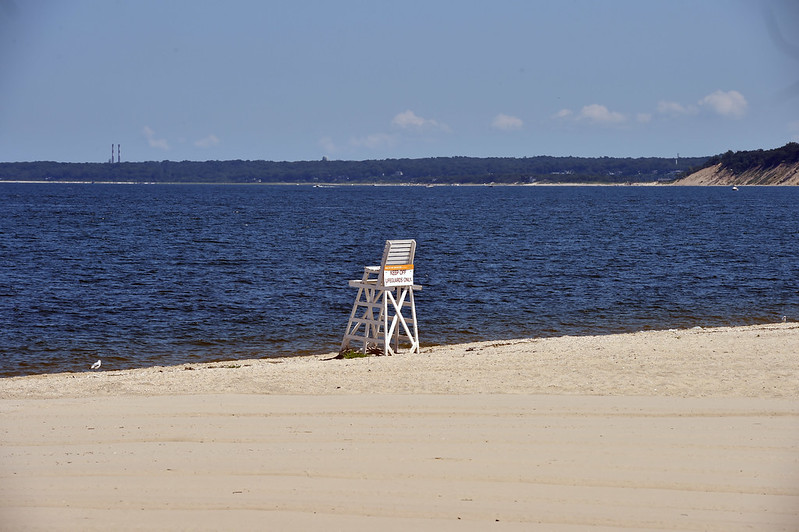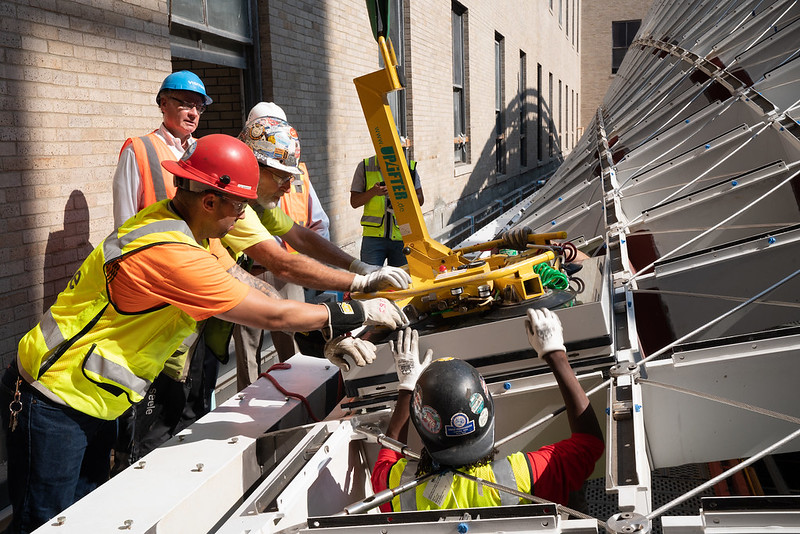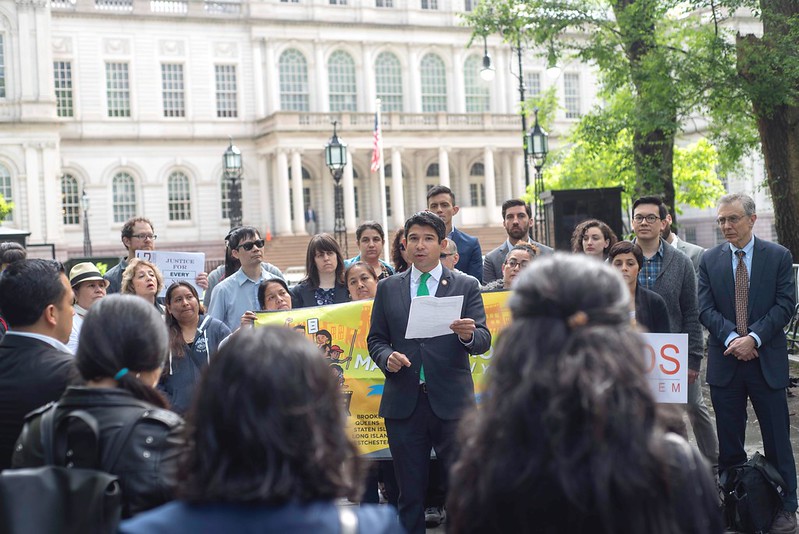Coronavirus, Climate Change and Coming Together Amid Catastrophe

The current crisis reminds us of the past and warns us about the future (photo: Kevin P. Coughlin/Governor's Office)
Everyone on Long Island remembers how it felt during Hurricane Sandy. We were paralyzed, waiting for the storm to pass, fearing for our families, homes, and basic needs. When the skies finally cleared, and we saw the scale of the destruction, it was clear that no individual one of us was strong enough, connected enough, or resourced enough to recover alone. We needed each other, we needed our community, we needed to come together.
Now, we’re facing another disaster, this one a global pandemic that has already sickened millions, killed hundreds of thousands, and left one in five Americans unemployed. We need to remember those lessons learned after Sandy. We must understand that we’re in this together.
The people who were struggling the most to get by before the pandemic started are the ones suffering the most now. Hourly and gig economy workers, the elderly, incarcerated and homeless people, and low-income communities of color are experiencing the most death and economic devastation.
They will also be the ones left behind after the next climate disaster. Long Island is one of the most segregated regions in the country, so it’s no surprise that COVID-19 cases and climate vulnerability are both staggeringly high in communities of color.
Part of this is because of climate and environmental injustice. A new study from Harvard University has found that exposure to air pollution heightens a person’s risk of dying from COVID-19. Here on Long Island, years of housing and environmental policy have ensured that black communities are stuck next to the worst polluting infrastructure sites. It’s no surprise that years of breathing in car and truck emissions can weaken a person’s lungs and make them more susceptible to COVID-19.
We can learn our lesson from Sandy and provide relief now by preparing for the future. Recovery funding and programs should be directed towards the most impacted communities, and should help reduce environmental pollution and thus COVID-19 and other vulnerabilities. As soon as it’s safe to do so, we can put people back to work by building renewable-energy and climate-resilient infrastructure, and target hiring and economic development for communities experiencing the most job and wage loss right now.
And, we can work to avoid the worst climate disasters. Many upcoming climate events are already “locked in,” but we can still come together to avoid the worst of the worst. New York now has one of the strongest climate laws in the country, the Climate Leadership and Community Protection Act. The CLCPA is one of the few laws that calls for emission reductions in line with scientific recommendations to avoid the worst climate outcomes. We can hold our government accountable to the law -- for example, by ensuring it continues to work on the emissions reduction plan during the PAUSE order -- to lessen the risk of worst-case scenario climate disasters in the future.
Reflecting on Sandy in light of the current moment, it’s clear that we did not learn enough about how to come together to keep people safe. People today are dying alone in overcrowded hospitals and nursing homes because our state and federal governments did not take the necessary action to protect people from catastrophe. We cannot let this happen again — not in our lifetimes, and not for our children, either.
As we recover from this pandemic, we must link the recovery with the solutions to the climate crisis. We should be investing in a system that places people before profits and addresses the root causes with bold effective action. We are in this together -- as we have seen, the cost of doing nothing is everything.
***
Lisa Tyson is Director of the Long Island Progressive Coalition, which works for racial justice, building community wealth, and realizing a just transition to a renewable energy future. On Twitter @LisaTysonLIPC.
***
Have an op-ed idea or submission for Gotham Gazette? Email This email address is being protected from spambots. You need JavaScript enabled to view it.
As Construction Sites Reopen, Access to Safety Training Must Too

Construction workers will be among the first back to work (photo: governor's office)
In the blink of an eye, COVID-19 brought most of New York City’s construction industry to a halt, leaving thousands of hardworking individuals jobless and struggling to make ends meet. Fortunately, Governor Cuomo recently announced a phased plan to reopen the construction industry, which will create an increased demand for workers.
But we can’t forget that as a requirement for employment in New York City’s industry, many construction workers and job applicants will need to complete additional safety training requirements.
Local Law 196, which required construction workers to have 30 hours of Occupational Safety and Health Administration (OSHA) safety training by December 2019, also requires workers to get an additional 10 hours of training – a total of 40 hours – by this September. That’s just a few months away – and thousands of current or prospective workers still need to meet the deadline.
Prior to the first deadline, Building Skills New York partnered with a wide array of local non-profits and other institutions, such as Hostos Community College and Public Housing Communities, to host OSHA-30 training sessions that helped provide free training to more than 300 workers. And of course, we were far from the only ones stepping up. That kind of work all across the city had a real impact on ensuring that more men and women entering the industry had the training and credentials needed to secure good jobs.
But now, with social-distancing mandates in place for the foreseeable future, it is not currently possible to receive OSHA training in a traditional classroom setting. That’s why it is critical for public and private sector partners to take two steps on this issue over the coming weeks.
First, more funding should be made available to connect current and prospective construction workers with virtual OSHA training opportunities. Workforce development groups like Building Skills are already doing this by shifting our digital operations and using remote technology capabilities to hold online OSHA sessions. Amid current virus concerns, this virtual training model is a no-brainer – it protects workers’ health while also giving individuals full access to construction employment opportunities.
Second, public officials should consider taking careful, data-driven steps to planning out a process for reopening in-person site safety training facilities. While OSHA sessions can be held online, other courses – such as the Department of Buildings’ series of 4-hour, 16-hour, and 32-hour scaffold trainings and the Fire Department’s F-60, G-60, S-92, S-93, and S-94 – must be completed in person. Just as state leaders have developed reopening plans for construction and other industries based on guidance from health experts, the same approach could be applied to spaces that previously housed safety training sessions.
Regardless of how we get there, it is incredibly important that nonprofits and other organizations are able to fund any necessary training sessions over the coming weeks and months. As we look to rebuild New York City’s economy, we must take into account individuals who live in underserved communities with an existing history of unemployment and underemployment. Current and prospective workers from across the five boroughs deserve the chance to access the city’s construction sector as new jobs become available.
Despite the city’s current site shutdowns, the construction industry will soon continue to provide real career opportunities for New Yorkers of all backgrounds. And just as public officials have taken a logical, systematic approach to reopening worksites, they must also look to make safety training more accessible to the men and women who will help build the future of our city in the wake of the COVID-19 pandemic. New funding for virtual courses is a great way to help us do that.
Building Skills looks forward to effectively confronting this new challenge alongside our incredible network of industry and non-profit partners – and we know that these efforts will help ensure that challenge is addressed for workers who need our support.
***
David Meade is Executive Director of Building Skills New York. On Twitter @BuildSkillsNY.
***
Have an op-ed idea or submission for Gotham Gazette? Email This email address is being protected from spambots. You need JavaScript enabled to view it.
Underappreciated and Underserved, Immigrant New Yorkers Need the City to Step Up

Council Member Carlos Menchaca, the author (photo: John McCarten/City Council)
As in past crises, immigrant New Yorkers are suffering acutely under COVID-19: this time with a cruel twist. While thousands of immigrants work on the frontlines, caring for the sick, cleaning the subways, and keeping us all fed in quarantine, so many are unable to pay rent, keep their businesses afloat, or stay home because of their exclusion from federal relief programs.
That hypocrisy alone should warrant intervention by New York state government, yet it hasn’t. Governor Cuomo has either blamed the federal government for not giving enough aid, or incorrectly claimed, as he did this week, that “the federal government has a number of programs to address” the plight of immigrants already.
The state’s lack of urgency reflects values and priorities as much as fiscal reality. But our city cannot afford to wait for the state to help more than 3 million of our own New Yorkers. We must have the courage to pass a budget that addresses their desperation, primarily because the city’s full recovery depends on it.
In New York City, more than half of immigrants are essential workers, immigrants own half the city’s businesses and contributed $232 billion last year to our GDP. That includes 360,000 undocumented immigrant workers and 48,000 undocumented business owners. A city budget -- due by July 1 -- that excludes immigrants from relief would be astonishingly hypocritical on this basis alone.
It would also be cruel. According to a survey recently conducted by Make the Road New York, nine out of ten immigrant households have at least one earner who has lost a job or income since the pandemic began. Of unemployed respondents, 88% are out of work because of COVID-19. With nine in ten immigrants also renters, more than half were unable to pay rent in April, and nearly every respondent worries they cannot pay in May.
Compounding this economic insecurity is lack of access to government assistance, as undocumented immigrants were largely excluded from federal relief – such as paid sick leave and unemployment benefits – even though they pay billions, annually, in taxes. Of those surveyed, only 15 percent reported receiving any support from the government at all.
Above all, the Trump Administration’s anti-immigrant agenda has proved to be a death sentence for our communities: pre-pandemic expansion of the public charge rule and escalation of immigration enforcement have caused many immigrants to shirk medical care, which puts everyone at risk. All the while, ICE continues to arrest and detain immigrants in COVID-19 infested facilities and the U.S. Department of Justice forces immigration courts to remain open for detained dockets, putting both immigration agents and public defenders at risk.
There is much New York City can do through the budget to help immigrant New Yorkers. Our current situation has exposed the critical gaps our budget fills: funding public defenders for the deportation defense of unaccompanied minors and detained adults; English proficiency classes for New Yorkers to navigate city life and government at all levels; and healthcare programs that are immigrant-led through trusted community partners, to name a few. We must fully renew funding for all immigration legal services and adult literacy programs; allocate funding for culturally sensitive health and mental health-care, and interpretation services like a worker cooperative language bank.
We can also pass existing legislation that would reform our commercial rent market; legalize e-bikes for delivery workers now that state authorization exists; and reform and expand our street vendor licensing system. These bills already enjoy overwhelming City Council support and their passage would send a clear message to immigrant New Yorkers that the city has their backs.
None of these things would come easy, and I appreciate, as a member of the Council’s Budget Negotiating Team, the competing priorities with which we are faced. But immigrants are not a special interest. If we do not secure the well-being of over 3 million New Yorkers, there is no recovery.
It is time for all levels of government to step up and recognize what over 120 grassroots-led mutual aid groups already know: that full recovery depends on the well-being of our immigrant communities. That praise for essential workers is hollow if we exclude most of their ranks from relief. And worse of all, we make a mockery of our collective effort if we leave so many behind.
***
City Council Member Carlos Menchaca represents parts of Brooklyn and chairs the Council’s immigration committee. On Twitter @CMenchaca.
***
Have an op-ed idea or submission for Gotham Gazette? Email This email address is being protected from spambots. You need JavaScript enabled to view it.




